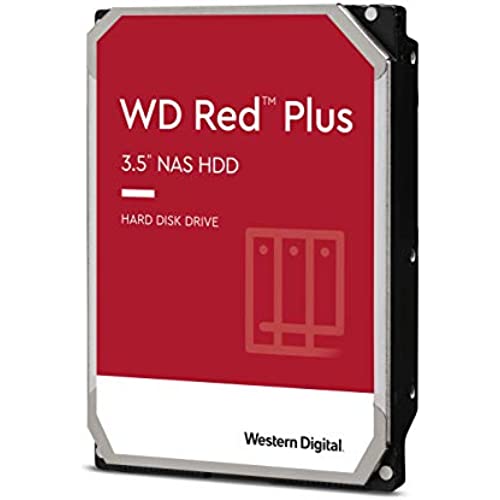
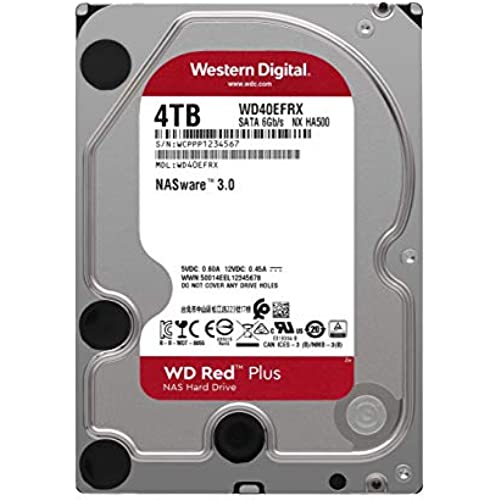
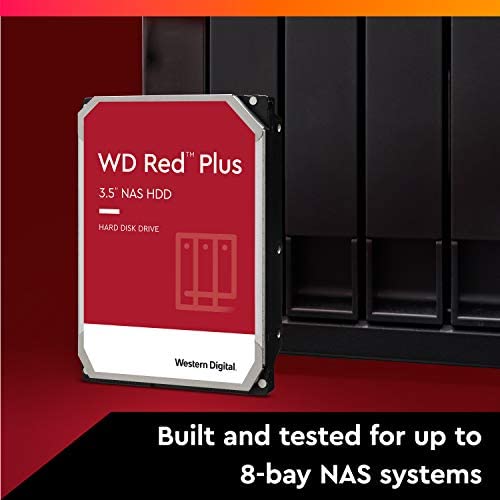
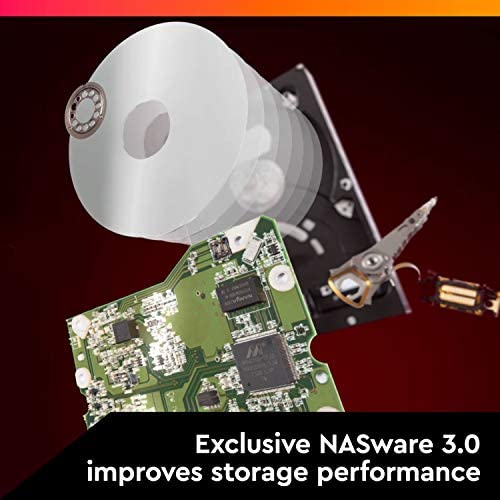

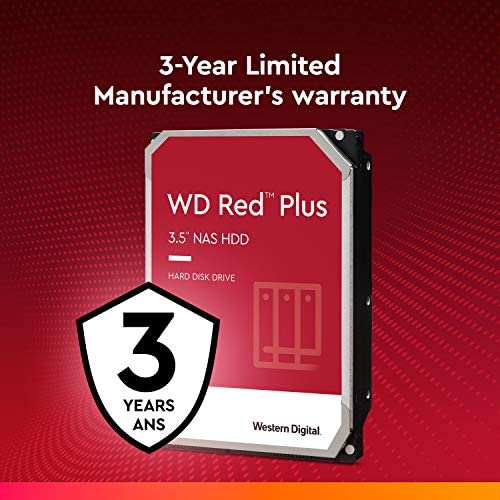
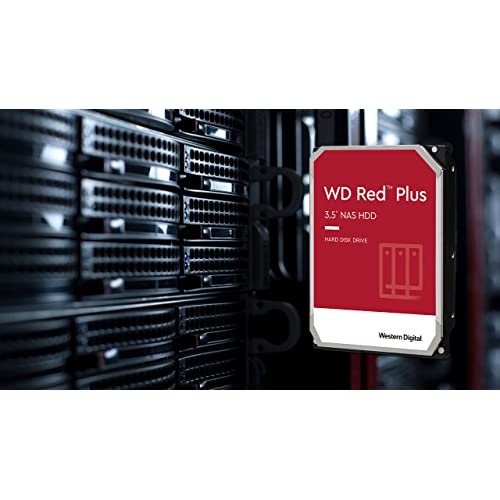







Western Digital 4TB WD Red Plus NAS Internal Hard Drive HDD - 5400 RPM, SATA 6 Gb/s, CMR, 64 MB Cache, 3.5 - WD40EFRX
-

Wael Abi-Haydar
Greater than one weekIve read a lot about these drives and how reliable they are, so I decided to try them for a change from normal/regular WD drives. I am used to WD green drives, which I use 24x7 (2x 500GB and 2x 2TB in RAID0) since 2010 without a single glitch (read/write some 10GB/day on average), the green drives are fantastic, and my SMART sensors still show very healthy indicators! I bought 4x3TB WD Red NAS to configure a RAID10 array, i need it for my massive music production samples collection (Kontakt 5 :-) ), sequential reading speed is crucial, so is redundancy, RAID10 is the key! Drives arrived a couple of days later than promised, its ok, things happen. I prepared everything right, done the backups, managed my ATX tower internal cables and controller ports to accomodate the 4 extra drives. plugged the drives, powered the system, and POOOOFFFFF, one of the drives is a Dead On Arrival!!!!! it just clicks and clicks and keep on clicking!!!! what a disaster! I mean to me its 4 brand new drives with one failing already, so 25% defect rate!!!! I contacted Amazon, they were very kind offered a replacement that arrives within 2 weeks as i live abroad, more wasted time, and i have to ship on my expense the defective product! too bad! I will wait for the replacement drive and update my review accordingly, i give 1 star due to already proven product reliability and RMA policy. Update: I should mention that Amazon customer were very kind and offered to me full refund for shipping the defective product back to the USA. The replacement drive arrived right on time, working great, I am increasing my rating from 1 star to 3 stars due to Amazon and WD great customer support. drives are in use since 6 months, all looks goods, cool drives, low temperature (27-35 Celsius) in the ventilated RAID cage. RAID10 on software IntelP55 SATA2 (3.0GT/s) using windows 10 x64: Sequential Read (Q= 32,T= 1) : 253.285 MB/s Sequential Write (Q= 32,T= 1) : 91.257 MB/s Random Read 4KiB (Q= 32,T= 1) : 15.873 MB/s [ 3875.2 IOPS] Random Write 4KiB (Q= 32,T= 1) : 2.962 MB/s [ 723.1 IOPS] Sequential Read (T= 1) : 135.242 MB/s Sequential Write (T= 1) : 59.555 MB/s Random Read 4KiB (Q= 1,T= 1) : 2.449 MB/s [ 597.9 IOPS] Random Write 4KiB (Q= 1,T= 1) : 0.442 MB/s [ 107.9 IOPS] Test : 100 MiB [E: 50.9% (1804.0/3540.9 GiB)] (x3) [Interval=5 sec]
-

Michael
12-06-2025Prime day deal had these at $170 each!! It was time to upgrade my NAS... again.. Replacing WD 6TB drives with 10TB drives. The 6TB drives will then migrate over to my 2nd NAS that has 2TB drives. Ive purchased eight 10TB Red Plus drives, I have been using nothing but Red drives on my NASs and I have a few. Never a problem with sound, heat or failures (knocks on wood). The 2TB Red drives have over 78,000 hours on them right now. They run 24/7 on a rack mounted APC. I believe the 6TB have over 40,000 hours. My only problem is the time it takes to rebuild the array with one drive replacement at a time. This problem is not due to the drive, but the performance of the machine, raid controller and how full they are.
-

MaddsPhoto
> 3 daySo far VERY GOOD. I actually just purchased this to use as a backup drive and I had a very specific mission that this helped me complete. From I dont know, 1999-Now Ive used close to 15 drives, going back to 16gb (or so) HDDs which were big back in the 90s up to 1tb drives of today, but I had a huge problem of missing files. Photos in particular. I was using drive bays to attach the old drives to the PC and try and search them all at once but Windows search really sucks. (Yes I should have booted into Ubuntu - shame on me), but I said, you know what, enough is enough, I know WD has these 6tb drives, let me literally copy the contents of ALL of the drives Ive ever owned onto it, and do one main search. Thanks to this drive, and some other creative methods *dusts self off* I did one big search of everything on this drive and found lots of old treasures, including the fountain of youth, just kidding. In recent weeks I realized, well, not that it would have helped with Windows not recognizing/initializing certain drives, but a freeware app like UltraSearch does things that windows explorer search refuses to, I guess Windows Explorer has dark moods, was tired of me playing Iggy Azalea on it, and went on strike when I tried to search for things; UltraSearch casts no aspersions with respect to my musical interests, so it just does searches for me regardless... Lo and behold, while I couldnt copy ALL the drives I own onto it, nor did I need to with respect to trying to find files from 10+ years ago, I was able to (with the help of Ubuntu), recover data off of drives that Windows 7 no longer read, but Ubuntu did, thanks Microsoft, and recover otherwise lost data onto this 6TB RED, and other newer drives from the 2000s. Its still got about 1.5tb free so Ill be using this as a third backup drive, keeping it disconnected from the PC not even in a NAS device, so I figure it will last ALOT longer. Perhaps putting it into a safe deposit box will ensure its survival in case of another Hurricane Sandy, or an Iggy Azalea attack of some sort.
-

Prof. Bryon McGlynn
> 3 dayThe reviews Ive read on this drive seem to praise how quiet it is. A review on techreport.com even stated, The WD Red 4TB is remarkably quiet; it emanates a faint hum while idling, and its seek chatter is barely audible from a few inches away.. I would agree that they are quiet while idling, but I have to say that as far as the seek chatter goes, this is not what I have experienced. I purchased 2 4TB drives from Amazon to put in my QNAP TS-251+ NAS. During certain times like booting up, launching certain apps, and copying file, I can hear the seek chatter from 10-15 feet away. In comparison, I have a 3TB WD My Passport drive that I would definitely say is quiet. I cant hear any noticable seek chatter from that even when Im right next to it. To put some proof behind what I was hearing, I put a decibel meter about 6 away from the NAS. The increase between when the drive was just iding and when it was seeking was on average about 5 dB with a peak around 7-8 dB. For those not familiar with the decibel scale, an increase of 10 dB means it is twice as loud. I decided to exchange the drives for 2 others, and unfortunately those sound just like the first 2 that I received. All 4 of the drives were manufactured in Oct 2015. Now Im not saying that its really loud, just that it is louder than I was led to believe it would be, especially since the 3TB WD Passport drive I have is not like this at all. So there are only 2 things I can conclude from this: 1. This seek chatter noise is normal for these drives and my expectations were just too high. (And maybe the NAS enclosure is amplifying the sound a bit) 2. I have bad luck and I have stumbled across a noisy batch of drives
-

Visualtang
> 3 dayI used this disk to replace a graphics and downloads drive on my home server. The old drive was a 1TB WD green from a few years ago. Since I figured I would give this drive a thorough run-through, I copied all the data using a USB 2 external adapter sitting on the floor on top of the bag the drive came in. It copied a few hundred thousand files of varying sizes in a couple of hours, mostly writing at about 31/MBs. I was surprised when it was running at how quiet the drive was and that it remained quite cool. After I pulled the old drive out of the server I compared the two, and this was actually lighter than the old 1TB green, I was surprised. In windows I ran a few crystal disk mark tests: The WD Red averaged 150 MB/s read and 130 MB/s write (Seq. 5 tests). The WD Green averaged 96 MB/s read and 88 MB/s write (Seq. 5 tests). Two Seagate 4TB drives (5900 RPM) in a Raid 1 averaged 143 MB/s read and 123 MB/s write (Seq. 5 tests). As the tests show, it outperformed the other drives, but the Seagates were definitely close and cost about 3/4 the price of the Red. I cant really speak for reliability since it has only been running a month, so my fingers are crossed for sure about that. My main problem with the huge storage drives available now is that it is pretty much mandatory to buy 2 in order to backup properly. You used to be able to get by backing up to tapes or discs, but its just not feasible with something like a 4TB drive. Heres hoping that this drive has Western Digital reliability and treats me as well as the old Green drive did.
-

Roboknight
> 3 dayI would give these things a 1 star review just to get people to read this, but not this time. Ive bought these WD Red drives before. I consider WD substandard equipment, *HOWEVER* my theory is, if your backup system cant host substandard equipment, then you need another backup system. Ive been using OpenSolaris and these WD Reds for over a year now, and I can see that already Im getting some errors with two of the original drives. They both show about 7k+ errors when you look at the smart report (something you should be doing if you arent. Do yourself a favor and build smartctl if you dont already have it.). So I expect Ill be replacing those drives first. At any rate, I dont think I got any DOAs from Amazon so far. Im doing a surface analysis on the new ones to see what kind of shape they are in. But, these drives are priced pretty well at about $0.39/MB. You can probably do a little better, but these are pretty good drives. One other thing to consider when looking at drives: there are drives with higher capacities (4TB, 5TB, 6TB as of this review), but before you consider those too hard, realize that you are trusting your data to statistics no matter WHICH drive you buy. The ECCs that these drives run are large enough that you are guaranteed to get errors (yes, guaranteed), just by the sheer volume of bits they contain. There is no avoiding it. However, at 3TB, that is about the sensible limit where your ECC doesnt outstrip your data. On the larger drives, the same ECC is used (so its size doesnt become ridiculously large), but that means you are taking much more of a risk losing data. This website explains it better than I can: http://blog.fosketts.net/2014/12/19/big-disk-drives-require-data-integrity-checking/ , but it is one of the reasons I choose the 3TB drives vs just buying bigger drives. I might do so in the future, possibly, since ZFS is pretty good at protecting against bit rot, but for now, these drives are about the right drive for long term data storage.
-

M. Cummings
Greater than one weekUpdate: 2016/10/10 - Amazon is accepting a return of the drives with the miss matching serial number. I bought the same drive advertised from Frys Electronics. My issue was unrelated to the drive itself. Im changing this to a 5 star because I am using the same type of drive without issue. WD tech support willing to help resolve my issue. For that I give my compliments to WD tech support. Update: 2016/10/01 - Im currently working with WD on this issue. I expect that Ill be changing this to a 5 star review in the near future. It turns out that the root of my problem was that both drives received were improperly packaged in the wrong box.The box had the correct SN and it did have the correct warranty for these drives. ___ Im giving this a 1 star because when I called W.D., they said both of my drives are OEM hard drives and that any RMA requests would have to go though the manufacture of the computer it was sold in. Im very confused by this because it the item isnt listed as OEM. If you buy one of these drives, register your device to verify it isnt an OEM drive. I bought a WD Red 3TB on 9/27/2016 (Received on 9/28) - Dead on Arrival - ASRock Motherboard bios wouldnt detect it. - ASUS Bios wouldnt detect it. (Used SATA cable / power that i used for a different drive) - Unraid 6 and Windows 64bit device manager wouldnt detect it. - External hard drive dock didnt work. - Data Lifeguard Diagnostic for Windows didnt detect it (using SATA port). - Called WD support and they told me the drive is bad. That I can do an RMA or return to amazon. I returned to amazon for a replacement. Replacement arrived 9/29 - Dead on Arrival (This time it shows up in bios, but makes clicking sounds after spin up. I speculate the clicking sounds are made when the computer is attempting to access the drive.) - Booted into ASRock bios. The drive name did show up. (Details about the drive including smart were unknown) - In windows device manager it showed the drive as unknown and not initialized. I would expect that, so I attempted to initialize the disk. Windows gave me an unknown path error. I didnt expect it to work, because the drive was making clicking sounds. 9/29: I called WD support again, this time to discuss the second drive. I provided the Serial Number of both drives to WD and they said the drives are OEM. OEM drives are not covered under the WD warranty. That the two drives I had were sold to a manufacture. That I would have to go though the manufacture to get a replacement under that manufacturers warranty. Im rather confused at this point because this item is sold by Western Digital according to the Amazon product page. Ive saved the S/N of the drives in case WD responds to this post wanting them. Personal Opinion: I bought WD Red for my Unraid6 server to build out a NAS due to the higher levels of vibrations when next to other HDDs. I find it very odd to have two hard drives DOA. If I heard someone else saying that, i would speculate that they had a bad cable or didnt know how to set up a new hard drive in their PC. Based on the reviews of the drive, Im going to assume that this is more of an isolated case. I would of forgiven this product for the failures due to the many unknowns during shipping. The only thing I couldnt excuse and the reason for the 1 star was that the dive didnt have a warranty according to WD because it is an OEM drive. Note on shipping: The hard drive box is marked as fragile, but that is contained within a generic amazon box. So the fragile warnings are not visible when the item is shipped. This could explain why the hard drives were damaged. Update: 2016/01/10 - Im in the process of packaging the 2 HDs to return. Ive discovered that the S/N on the boxes do not match the drives they shipped with. WD has replied to my review. I will be calling them and updating the review after. Update: 2016/10/01 - Ive contacted both WD and Amazon about the issue. Amazon noted on my return that the SNs wont match.
-

gadgetfreak
> 3 dayThis purchase was made as a replacement for the same drive that had recently failed after about 2 years of backup-only use. I do not test the drive for speed, as thats not its purpose (I have WD Blacks and SSDs for that). Im purchasing strictly for reliability. So why the 3 stars? Pros: - The drive offers good capacity at reasonable prices - Designed for use in NAS or other similar applications - Runs seemingly cool Cons: - I had one fail not too long into its life (e.g., ~2 years) - That warranty is potentially useless if, like me, you are nervous about sending a non-wiped drive back to WD for replacement. I will elaborate on the concern... I contacted WD about the failed drive, and they readily were willing to replace it. That being said, since the drive has failed (clicking sounds, etc.), it is impossible for me to get it to mount, and therefore it is impossible for me to erase the drive. I suspect that with very little effort, someone with a little hardware expertise -- e.g., lots of people at WD -- could get the drive working again and have ready access to all my info. Give this 4TB drive is the clone of my entire digital life, I just wasnt comfortable sending the drive back to the company. And of course, if I were to crack the thing open, Id void the warranty. Ive read lots of views online about WDs policies and procedures on protecting info, but when it came down to risking all my info, I wasnt able to pull the trigger on the exchange. For other utilitarian data, Id have no such qualms. Obviously, this is a personal choice and you may be more trusting than me. In which case, paying a little extra for a 5 year warranty makes sense. So consider what you would do in a similar situation as mine. If you have come to view spinning-platter drives as disposable items, consider saving a bit of money and buying something with a shorter warranty -- particularly in an application like mine (a clone) where its easy to swap a new drive in. Undoubtedly you will pay less per TB in a year or two. Or youll go SSD if the pricing is finally right.
-

Dr. Kattie O'Hara DVM
> 3 dayI purchased this from Amazon Warehouse in Used-Acceptable condition. Running an initial S.M.A.R.T. test revealed 0 Bad Sectors, however, the drive did have a drive reconnection count of 13. While 13 for this metric is not good, I monitor it weekly, and no new drive reconnects have occurred. As the drive had a relatively low 400 hrs when I received it, I was ok keeping the drive, given the 30% discount from full price. I recommend buying WD Red drives from Amazon Warehouse when the discounts are warrant it. I think these are a great value. Make sure to research the spin RPMs and whether the drive is CMR or SMR. Many of the WD Red drives may be advertised as 5400 RPM Class, but they actually run at 7200 RPM. Lastly, avoid any SMR drives altogether.
-

Caramon
Greater than one weekI ordered 3 of these back in October of last year to use in my HTPC. Recently I was running out of space and ordered another one along with 3 - 4TB Greens for a backup solution. Upon reading up about the greens, which I had never ordered before, I learned about WDs WDIDLE3 utility that some people are using to set the Head Park timer from 8 seconds to 5 minutes and thus reducing the amount of times the heads park. Since the Greens are only rated at 300k cycles, you could see how quickly those would add up of they are parking every 8 seconds after use. On a whim, I decided to check the new Red drive I just purchased to see what its timer was set to, it was 5 minutes. I then checked the Red drives I purchased here from Amazon back in October of last year, the same 4TB model as the one I just ordered. To my surprise, all 3 were set to 8 seconds and my head park count was already at 18k in a matter of months. I used the utility and set those to 5 minutes as well. Performance of the drive was not really what I bought them for, but they seem to be fine. Their not Black drives and 7200 RPMs, so their not as quick as what I have in my gaming machine, but they work just fine for my HTPC.
